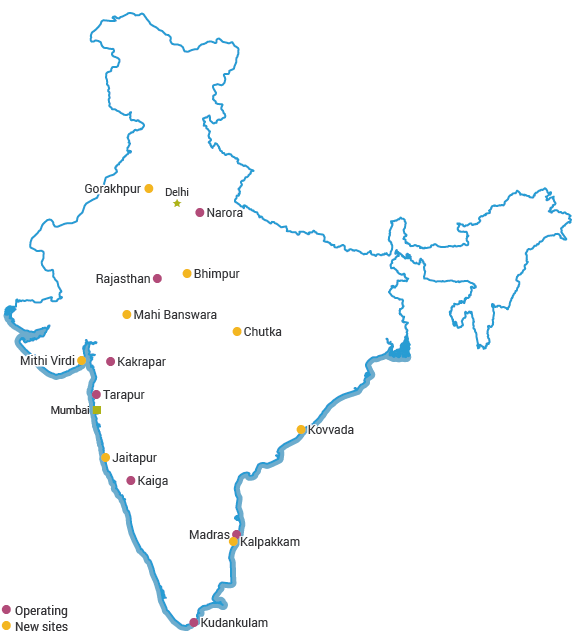Governance
Year End Review 2019: Department of Atomic Energy
- 30 Apr 2020
- 8 min read
Important Policies and Programmes
Nuclear Power Programme
- Kaiga Atomic Power Station (KGS-1) has set the world record of 962 days of continuous operation.
- Tarapur Atomic Power Station Units (TAPS 1 &2), connected to the grid in April and May 1969, have completed 50 years of safe operation. TAPS- 1&2 are currently the oldest operating power reactors in the world, producing reliable power at about two rupees per unit.
- At present, there are 22 reactors with an installed capacity of 6780 MWe operating above 80% plant load factor in the country.
| Nuclear Power plants in Operation | Nuclear Power Plants under Construction | Planned Nuclear Power Plants |
|
|
|
- Among these eighteen reactors are Pressurised Heavy Water Reactors (PHWRs) and four are Light Water Reactors (LWRs).
- The nuclear energy programme in India was launched around the time of independence under the leadership of Homi J Bhabha.
- Prototype Fast Breeder Reactor (PFBR) is being implemented by the Bharatiya Nabhikiya Vidyut Nigam Limited (BHAVINI), a wholly owned Enterprise of the Government of India under the administrative control of the Department of Atomic Energy (DAE).
Indian Nuclear Energy Programme
- The main objectives of the Indian Nuclear Energy programme are to provide safe and reliable electric power for the country’s social and economic progress and to be self reliant in all aspects of nuclear technology.
- Exploration of atomic minerals in India, undertaken since the early fifties, has indicated that India has limited reserves of uranium (natural uranium consists of mostly 238U, with 0.7 % 235U), but fairly abundant reserves of thorium (232Th).
- Accordingly, India has adopted a three stage strategy of nuclear power generation:
- Stage 1 Pressurised Heavy Water Reactor (PHWR): The PHWR is a pressure tube type reactor using heavy water (D2O) moderator, heavy water coolant and natural uranium dioxide fuel. Considering the growing energy demands and the necessity to increase the energy potential, a second line of light water reactors have been added to the current indigenous programme of Pressurised Heavy Water Reactors.
- Stage 2 Fast Breeder Reactor (FBR): India’s second stage of nuclear power generation uses the Pu-239 obtained from the first stage reactor operation, as the main fissile element of fuel core in fast breeder reactors (FBR). A blanket of U-238 surrounding the fuel core undergoes nuclear transmutation to produce fresh Pu-239 as more and more Pu-239 is consumed during the operation. The Fast Breeder Programme is in the technology demonstration stage. Sodium, because of its good heat transfer and nuclear properties, is used as the coolant to remove the heat generated in the reactor.
- Stage 3 Thorium based Reactor: Thorium utilization is the long term objective of the Indian Nuclear Power Programme. The third phase of India’s Nuclear Power Generation programme is breeder reactors based on Thorium- Uranium-233 cycle.
Civil Nuclear Cooperation
- Progress has been made in India’s bilateral international engagement in civil nuclear cooperation with major partners.
- Discussions are underway with Russia (ROSATOM) for building 6x1200 MWe nuclear power plant at a new site.
- Negotiations with France are in an advanced stage for implementation of the Jaitapur project (6x1650 MWe).
- Discussions are underway with USA for building 6x1100 MWe nuclear power plant in Kovvada (A.P.)
- Significant outcomes have been achieved in fuel supply arrangements with major global suppliers viz, Canada, Kazakhstan and Australia.
NCG-Vishwam Cancer Care Connect
- DAE has launched a global cancer care network, “National Cancer Grid (NCG)-Vishwam Cancer Care Connect” (NCG-Vishwam 3C) on 17th September 2019.
- NCG-Vishwam envisages integration of the hospitals and relevant cancer care institutes in partner countries with the National Cancer Grid (NCG) of India.
National Cancer Grid
- National Cancer Grid (NCG) is a network of major cancer centers, research institutes, patient groups and charitable institutions across India with the mandate of establishing uniform standards of patient care for prevention, diagnosis, and treatment of cancer, providing specialized training and education in oncology and facilitating collaborative basic, translational and clinical research in cancer.
- It was formed in August 2012.
Glass Vitrified Cesium Pencil
- World’s first of its kind Glass vitrified Cesium pencil, extracted from high level radioactive waste for blood irradiation application has been developed and 7 such blood irradiators have been supplied to hospitals.
- The irradiation of blood is very much essential to prevent Transfusion Associated – Graft Vs Host Disease (TA-GVHD) particularly for immune-deficient patients. Various qualities of Cesium, such as longer half life, lower shielding requirement and amenability to be used in non dispersive glass form makes it a more suitable irradiation source over the currently used Cobalt-60.
Radiopharmaceuticals
- Ready to use 4 new Radiopharmaceuticals for imaging of Neuro-endocrinetumours, bone pain palliation, and treatment of liver have been launched. These are in addition to 14 varieties of medicinal radioisotopes/radiopharmaceutical products developed and supplied for diagnostics, therapeutics and palletic use.
- Radiopharmaceuticals are unique medicinal formulations containing radioisotopes which are used in major clinical areas for diagnosis and/or therapy.
Radioisotopes
- Different isotopes of the same element have the same number of protons in their atomic nuclei but differing numbers of neutrons.
- Radioisotopes are radioactive isotopes of an element. They can also be defined as atoms that contain an unstable combination of neutrons and protons, or excess energy in their nucleus.
- Some radioisotopes used in nuclear medicine have short half-lives, which means they decay quickly and are suitable for diagnostic purposes; others with longer half-lives take more time to decay, which makes them suitable for therapeutic purposes.
- Industry uses radioisotopes in a variety of ways to improve productivity and gain information that cannot be obtained in any other way.







